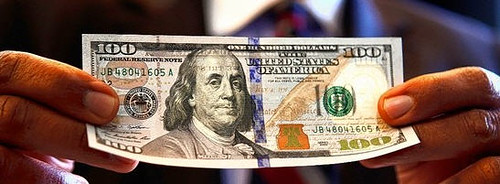
PREV ARTICLE
NEXT ARTICLE
FULL ISSUE
PREV FULL ISSUE
NEW 2011 $100 BILL DESIGN UNVEILED
Dick Johnson and Bill Malkmus pointed out the announcement of the new $100 bill design from the U.S. Treasury. I've excerpted the Wall Street Journal coverage of the event. I almost signed up to attend the unveiling, which took place in the historic, ornate Cash Room of the U.S. Treasury building next to the White House in Washington, D.C. Alas, I had a meeting and was unable to go.
-Editor

The Treasury Department unveiled what it calls "the next generation one hundred," a redesigned $100 bank note to stay ahead of counterfeiters. The new $100 notes will be available on Feb.10, 2011. The familiar portrait of Benjamin Franklin remains in the usual spot. But a historical reference to the quill used by the Founding Fathers appears superimposed over phrases of the Declaration of Independence and a 3-D security ribbon crossing the center capture attention. The images on the ribbon move as the bill is tilted. It's all designed to thwart attempted fakes. By now, the government has become intimately familiar with the process of rolling out new money. Over the past decade, the $20, $50, $10 and $5 have all received makeovers. The new look puts the finishing touches on what the government calls its second major redesign. The $100 bill last got a makeover in March 1996. As a rule of thumb, the Treasury redesigns currency every seven to 10 years because advancements in technology have made counterfeiting outside the norm of professional criminals possible. The name of the game is to make notes that are hard to counterfeit but easy for the public to authenticate. In 1996, when the $100 currency was last redesigned, it got a portrait watermark, an embedded security thread and color-shifting numeral 100. This time around two of the most prominent features the public will notice right away are a 3-D security ribbon woven into the paper and a bell in an inkwell. The 3-D security ribbon contains images of bells that transform to numeral 100s that turn into images of bells, and back again, as the note is moved. When the note is tilted back and forth, some images on the ribbon appear to move side to side. If the note is shifted side to side, these images slide up or down. What's at work is a new security technology called Motion that was developed by Visual Physics, a subsidiary of Nanoventions, based in Atlanta and acquired by Crane & Co., the manufacturer of U.S. currency paper based in Dalton, Mass. Sweden's 1,000-kroner banknote was first to use this technology. Crane & Co. wouldn't comment for this article. As for the bell-in-an-inkwell feature, when the note is laid flat on a table, only a solid copper inkwell is visible. When the note is moved, the inkwell changes color from copper to green. The movement will also make a Liberty Bell appear. In addition, the reverse of the $100 note will now show the back instead of the front of Independence Hall in Philadelphia. The changes will increase the government's cost of making a single $100 note to 11.8 cents per note from 8 cents per note. The average $100 bill lasts between seven and eight years.
To read the complete article, see:
Money Makeover: $100 Bill Gets Facelift to Fight Fakes
(online.wsj.com/article/SB10001424052748704133804575197990310606472.html)
The Numismatic Bibliomania Society is a non-profit organization promoting numismatic literature. See our web site at coinbooks.org. To submit items for publication in The E-Sylum, write to the Editor at this address: whomren@gmail.com To subscribe go to: https://my.binhost.com/lists/listinfo/esylum All Rights Reserved. NBS Home Page Contact the NBS webmaster 
|